B2B sales is a hard nut to crack.
It includes high stakes, long-term relationships, and extensive research. At times, it can seem impossible. Therefore, to seal good deals, you need to have a fair idea on the entire dynamics of B2B sales.
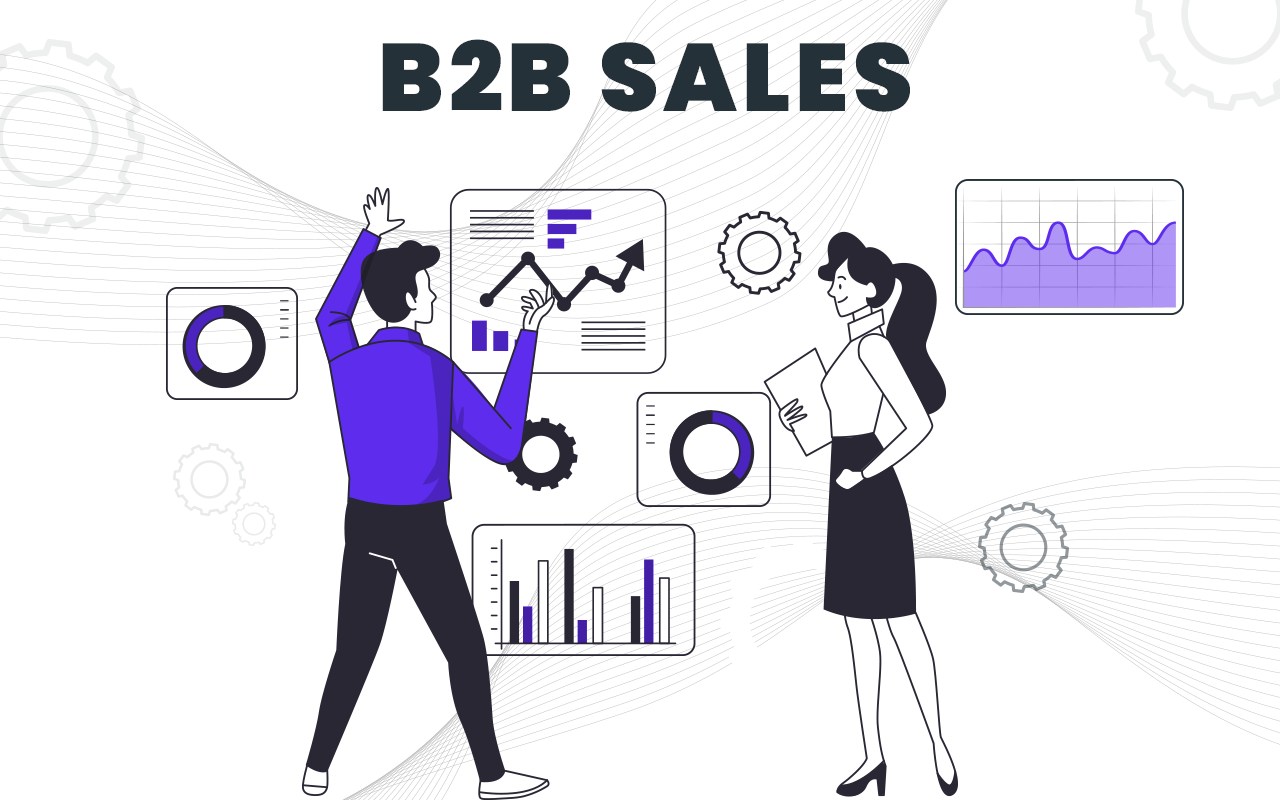
This guide will explore what B2B sales is, its types, and the importance, for you to get a better grasp on it.
What is B2B Sales?
Business-to-business (B2B) sales is the process of selling services, products to other businesses. Or, to put it more simply, in B2B sales, one company is the buyer and the other company is the customer.
B2B is the counterpart of B2C. Although they have similar sales characteristics and strategies, including relationship building and customer loyalty, there are some important differences that exist.
Differences between B2B & B2C
Nevertheless, B2B and B2C are two sides of the same coin. B2C or Business-to-Consumers is the process of selling products and services directly to customers or individuals.
Spotify is a significant B2C company where users get access to a library of music tracks, while Shopify is a classic B2B company.
Below mentioned in the table are the main differences between them.
| Criteria | B2B Sales | B2C Sales |
|---|---|---|
| Target Audience | Other businesses, decision-makers, and professionals | Individual consumers |
| Sales Cycle | Long and complex | Shorter and more straightforward |
| Relationship | Focused on building long-term relationships | Often transactional with less emphasis on relationships |
| Decision-Making | Multi-staged with several stakeholders involved | Usually made by an individual or household |
| Purchase Motivation | Based on logic, potential ROI, and business needs | Driven by emotion, personal desire, and brand appeal |
| Pricing | Often negotiable and may involve volume discounts | Fixed pricing with occasional discounts and offers |
| Product/Service | Customizable and complex | Standardized and simple |
| Marketing Approach | Personalized, niche-focused, and educational | Broad appeal, emotional, and aspirational |
| Buyer Education | High level of education required about the product | Lower level of product education needed |
| Sales Process | Consultative selling with a focus on value addition | Direct selling focusing on benefits and convenience |
With a valid understanding of the differences between B2B and B2C sales, let us learn the various types of B2B sales.
Types of B2B Sales
B2B sales is a dynamic domain; its types have been carefully categorized into the primary four based on the nature of the relationship between the buyer and the seller.
Each has its own characteristics; understanding them will benefit you when navigating future sales.
- General Service Providing
- SaaS/DaaS
- Bulk-selling
- Reselling/Retailing
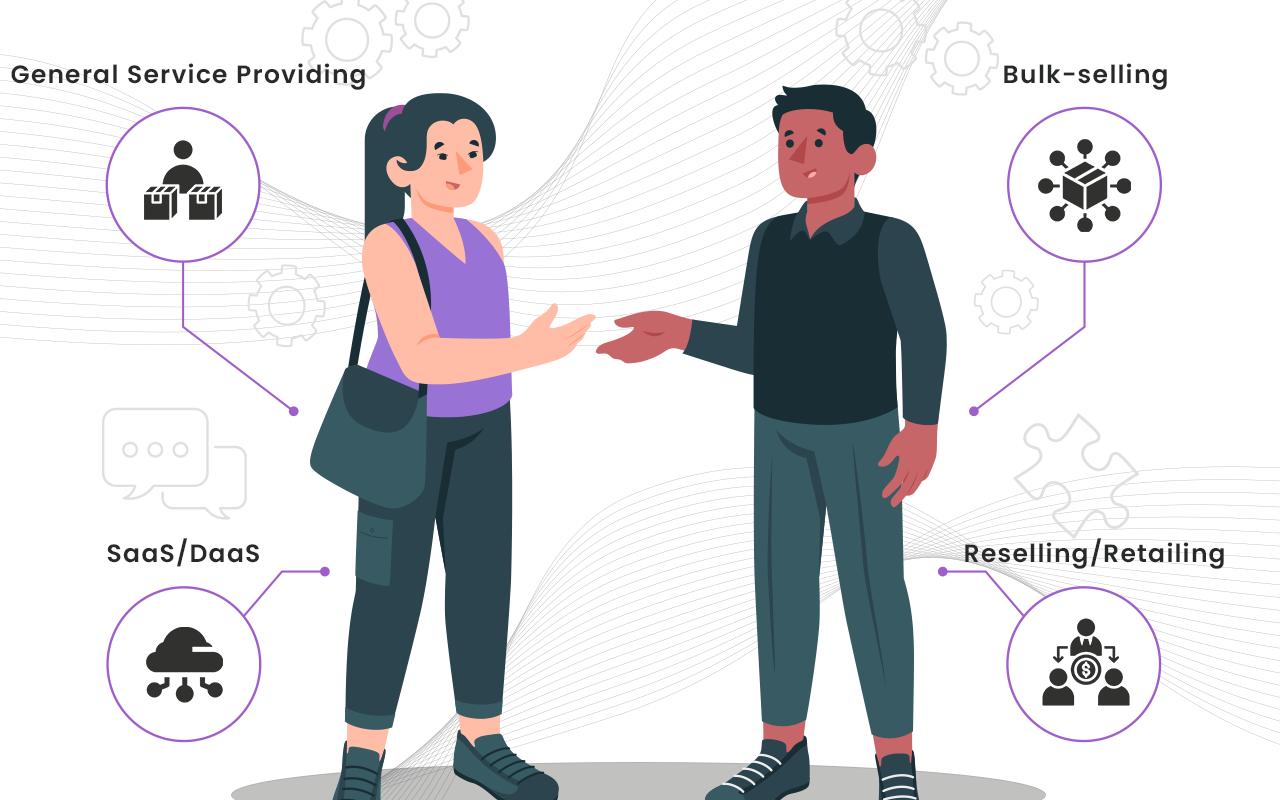
General Service providing Sales:
They are companies that offer well-defined and standardized services to other businesses.
Examples are physical equipment selling companies and B2B catering services. Caterpillar is a well-known company that sells physical equipment like dozers, engines, generators and many more to B2b companies.
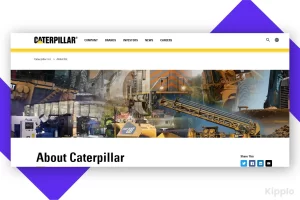
SaaS/DaaS Sales:
The business sells web-based software to other companies digitally. SaaS refers to software as a service where users can access the software with internet usage without having to download it.
Salesforce is one of the top cloud-based CRM software that seeks to increase the sales of businesses.
DaaS refers to Data as a service provider where they are third-party providers who offer data to other businesses.
An example is Kipplo, a data-providing service that helps other businesses acquire data and get market insights to generate leads.
Bulk-selling Sales:
There is a middleman between product manufacturers and retailers or other businesses. They are also called wholesalers, who buy products in large amounts and resell them in small quantities to individual retailers.
Sysco, a wholesale and a b2b e-commerce company is an example that distributes products like kitchen equipment, food products, and many more.
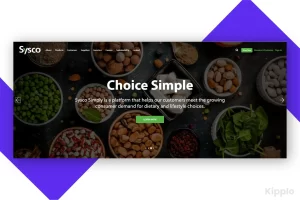
Reselling/Retailing Sales:
The companies purchase products and services but don’t utilize them. Instead, they resell it to other businesses. They include retailers, brokers, etc.
For example – CDW Corporation is a leading example of a reseller company where the company purchases IT and technology products from manufacturers and resells it to other business.
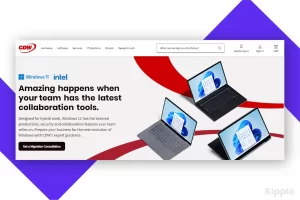
Since you know about the types, it is imperative that you understand the mechanics of a B2B sales process in details. Let’s delve into it a little deeper.
Process of B2B Sales
B2B sales is a strategic process that guides you to convert potential prospects clients. It includes a combination of – outbound and inbound sales, which plays a vital role in the process.
“Did you know that it takes approximately four months for a B2B company to acquire a new customer?”
Yes, it is because many stakeholders are involved in the sales decision, which leads to longer duration, to close the deal.
Another reason is that the B2B audience spend more time identifying and mitigating risks. They seek products and services that will generate revenue, improve performance and enhance their credibility.
Before we delve into the sales process, you need to know and remember what an Ideal customer profile (ICP) is.
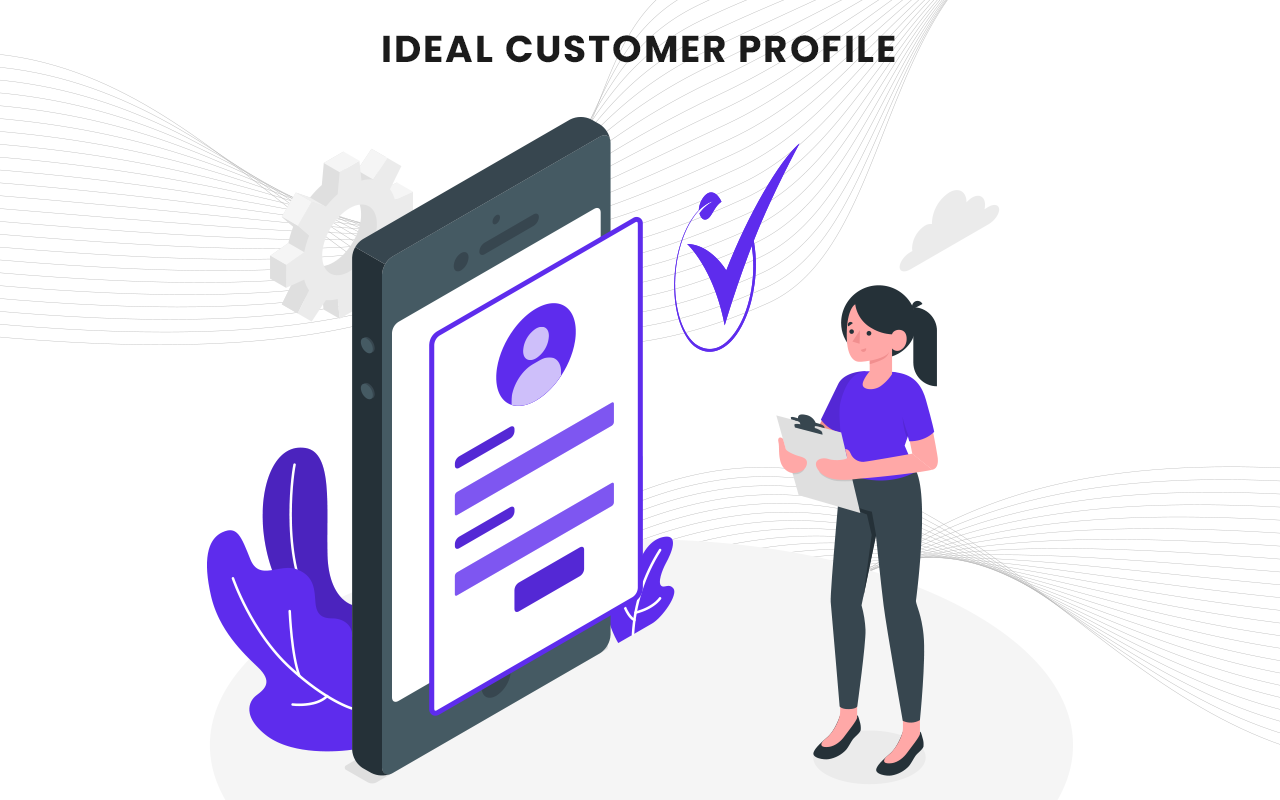
It is an acronym used by sales and marketing teams to refer to the behavioural characteristics of businesses that has the potential to be converted to high-value customers. Sometimes, you must re-evaluate everything to improve your sales process. Let’s go back to the beginning.
Understand
- Who is your audience?
- What kind of products are they looking for?
- What type of solutions are they looking for?
For your understanding, we have extensively crafted the Inbound and Outbound sales stages below. Their stages are different from each other, but most of them are broadly similar.
Let us now understand the entire process in-depth for your clarity.
Inbound sales
It is a process that involves prospects coming to you to buy products when they are ready. These prospects display a higher level of awareness and engagement.
Did you know Inbound leads cost more than average Outbound leads?
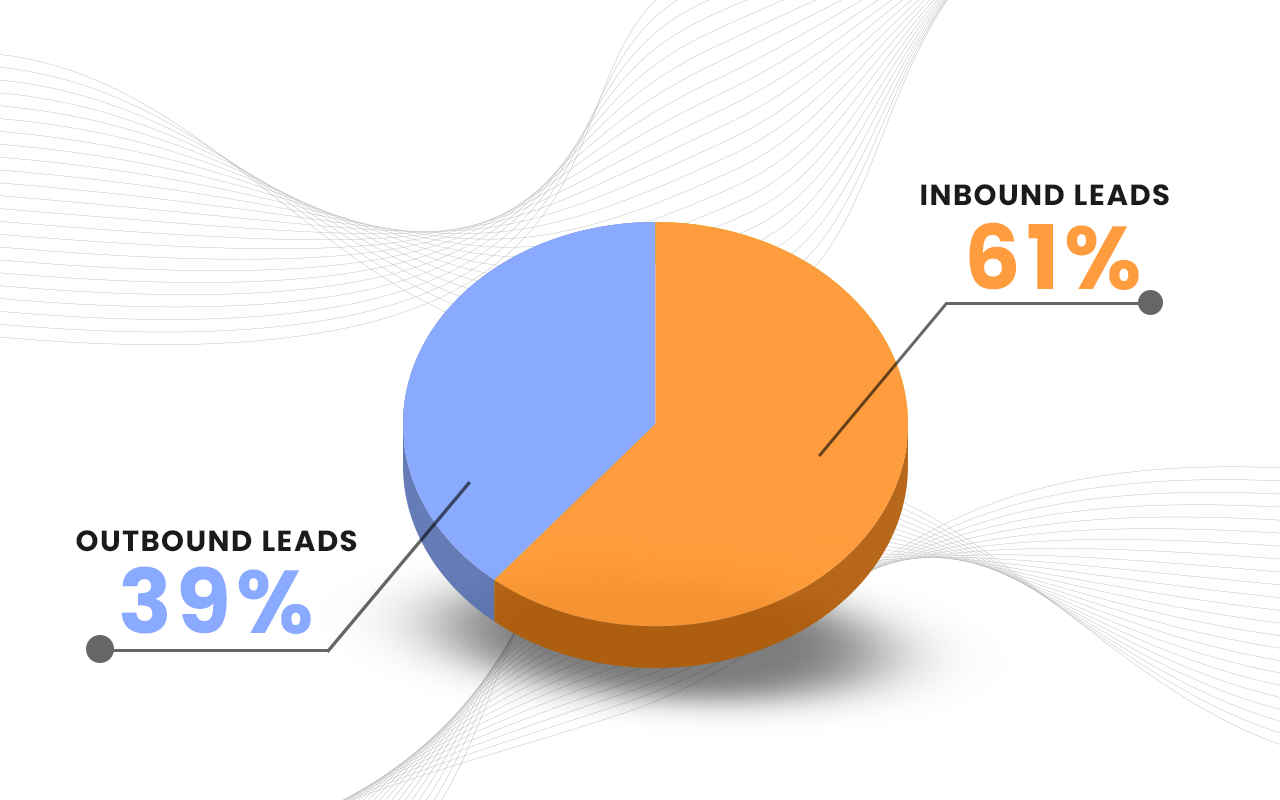
Inbound Lead Generation
The first step of inbound sales is lead generation. It relies on attracting leads through content marketing, social media engagement, and SEO optimization.
Here, you address their pain points and pull them through creating content such as
- Blog posts
- White papers
- EBooks
- Podcasts
- Webinars
Outbound Sales
Outbound Sales is a proactive approach to reaching out to potential prospects. It involves intense research and good communication skills by the sales team to turn them into leads.
Outbound Lead Generation
The first step of outbound sales involves lead generation too. However, it begins with identifying and researching potential prospects with
- Sales Intelligence Tools
- Industry Reports
- Databases
Some of the methods that are used in outbound sales to help generate leads include
- Cold calling
- Networking
- Cold Emails
“Data-providing software like Kipplo helps you identify the right prospects.”
The main difference is that in inbound sales, the buyer reaches out to the company, and in outbound sales, the sales rep reaches out to the buyer.
| Outbound Lead Generation | Inbound Lead Generation |
| The sales rep reaches out to the buyer | The buyer reaches out to the company |
| The communication is personalized | The communication is customized |
| Cold calling, Cold emails | Social media, content marketing |
After the lead generation process, the sales rep moves to the next step which is the engagement phase.
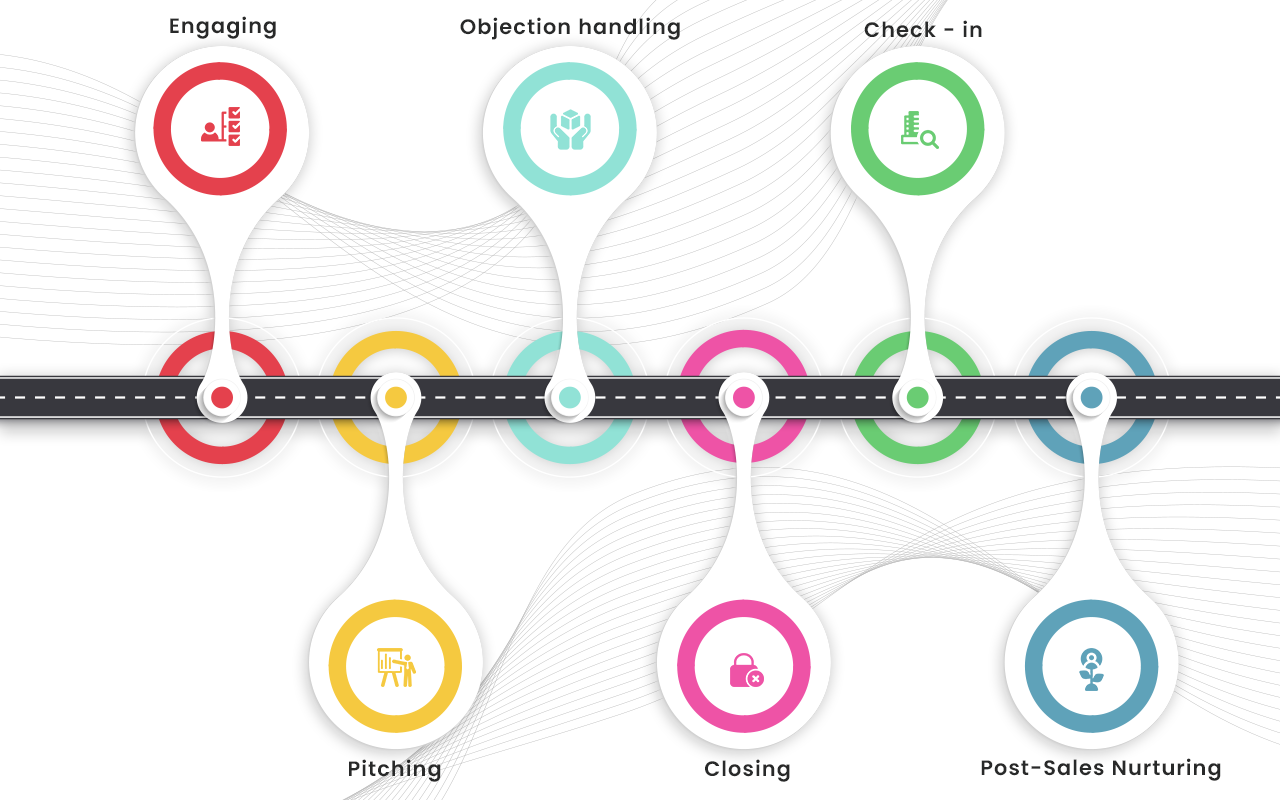
Engaging:
In this step, you have to conduct a needs assessment.
The sales rep should ask the right questions and build a rapport. This includes gathering information about the prospect’s needs and wants and determining how the offered product or service will meet those requirements.
At this point, salespeople must listen actively and tailor their presentation to show how their solution meets the customers’ needs. It will help increase your chances of closing the sale.
Pitching
After the engagement stage is done, the pitching stage begins.
The sales rep understands the prospect’s needs, pain points, and how the product helps the prospect.
It includes understanding your prospect’s needs and wants, as well as being able to convey your message clearly and concisely.
Here are some tips to tailor a good sales pitch
- Generate curiosity and be concise with your pitch. It solves the problem of endless discussions.
- Try to provide solutions by identifying the prospect’s problems.
- Paint a clear picture with accurate data and research.
After you have successfully pitched to your targeted prospects, the next phase commences.
Objection Handling
During this time, as a sales rep, you will actively address the prospect’s concerns and disapproval that may arise during the presentation. You listen carefully to their clients and try to understand their point of view, providing confirmation and other information to remove objections and build confidence.
This increases your chances of sealing the deal.
After the objection handling process is completed, it is time to clinch the deal.
Closing
Once the prospect is satisfied with the product or service, they close the sale.
This includes
- Negotiating the terms of the sale
- Including price, delivery, and payment terms
- Concluding the sales contract.
The sales rep should find a number that places both the parties in a win-win situation, offer flexible payment and delivery options, and address any final questions or objections the buyer might have.
Check-In
This is a crucial B2B sales process that occurs after the sale. This includes ensuring customer satisfaction and resolving issues that emerge. Maintaining constant customer communication is vital to building long-term relationships that can lead to repeat business and increased revenue.
Post Sales Lead Nurturing
The nurturing part of the sales process focuses on continuing to engage with the prospect and reinforce value even after the sale is complete.
The nurturing phase is requires enormous patience and smooth communication from your end.
It focuses on
- Informing the prospects about additional services that you can provide.
- Sending them emails on ways to help them in the future.
- Continuing to check up on them and nurturing the existing relationship.
When presented with marketing offers, old customers have a 60-70% chance to invest more than first-time buyers. Hence, it is crucial to keep nurturing with the existing prospects after the deal has been sealed too.
Now you have a grasp on the entire process, it is no longer like finding a needle in the haystack.
Let’s move towards the channels that you can use to generate more leads.
Most Popular B2B Marketing Channels to Generate Leads
- Email marketing – You send emails to other businesses to promote your products and services
instead of sending them to individual customers. The objective is to build prospect relationships, increase
brand awareness, and drive sales. It is cost-effective and easily trackable.
- According to Backlinko, 82% of B2B companies use email marketing
technology.
- Organic search:“76% of trackable B2B website traffic
comes from organic search.” By developing web pages focusing on the SEO terms your potential customers, clients,
users or businesses are searching for, you can attract them to your website to learn about your services. You
can identify new opportunities and customer intent as well. Additionally, it helps you to get insights about the
market and understand the prospects better. - Social media: According to LinkedIn, 75% of B2B buyers use social media to make purchasing decisions.
- Business-oriented social media platforms like LinkedIn, Instagram, and other platforms can help you establish
yourself as an industry expert. It involves creating relevant social media posts to promote products and
services. It engages with the targeted prospects, builds awareness and network, and maintains the existing
client relationship.
- Paid search: It is a powerful tool to generate leads and sales with search engines. Google Ads
is the most common example for it. You can bid on the right keywords and get leads for a low cost per click.
- The paid search market is worth approximately billion in the US. -Insider
Intelligence
- Content marketing:Blogs, eBooks, and product tutorials boost SEO, increase brand awareness, and
help customers evaluate your products. It includes developing and distributing content like blogs, social media
posts, emails, videos, etc., to potential prospects. It helps in nurturing and educating the new as well as the
existing prospects.
- According to Seomator, content marketing is an increasingly
critical part of B2B marketing.
- Influencer marketing: It is a marketing strategy where businesses collaborate with
digital influencers on social media to promote their products and services to other companies. Some B2B Influencers
are executives, entrepreneurs, authors, bloggers, etc.
- The study from the TopRank Marketing blog found that 86% of B2B marketers who work with influencers are
successful.
Now, imagine that you know about the B2B marketing channels, but how will you demonstrate the product’s value?
Bingo! It is through the magic of B2B product promotional methods.
Effective B2B Product Promotional Techniques
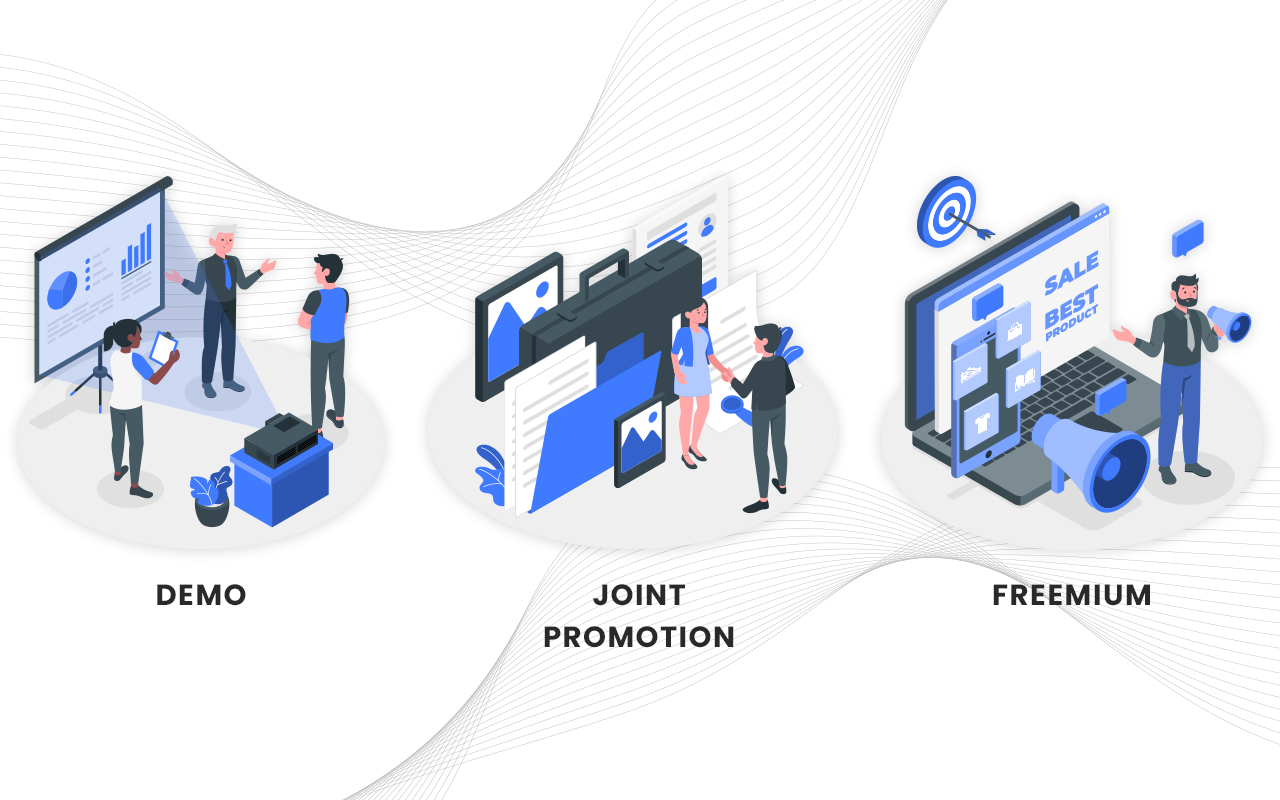
Demo
Demos are a great way to get a chance to test a product or service without any issues or reliability. In fact, marketers may offer free samples of their products or services. Consider combining a free trial or demo with a limited-time rate to drive conversions.
Ex. – Atlassian is a big company that uses the demo method to resolve various customer problems.

Joint Promotion
Here, two companies announce a joint venture, and they try to get better results by reaching their customer and prospect bases. It’s common in B2B organizations where marketing professionals run campaigns that amalgamate all these services into one package at one great price.
Ex. – LinkedIn, a professional networking platform, and HubSpot, a marketing, sales, and service software provider, have integrated their services to improve business performance and marketing.
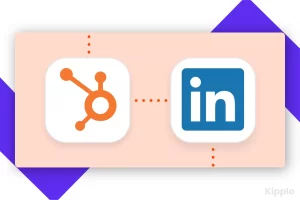
Freemium
A freemium version provides free access to some software features without any time limit. It allows potential customers to understand the product’s core value before committing financially to the product. It is an easy technique to get hold of a large audience.
Slack is one such company that offers the freemium version. This version provides certain features that a user can access for a lifetime.
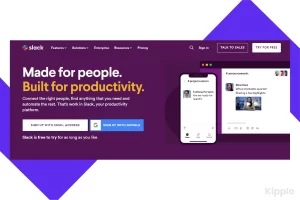
Besides these sales promotional techniques, there are three Rs in this domain that you need to be aware about.
- Risk Free
- Reciprocity
- Reward
“Are you aware that 7 is considered lucky for marketers to be competent to drive a lead to purchase?”
Let’s be real!
Yes, it means marketers need at least an average of 7 interactions to transform a prospective buyer into an actual one.
Rule of 7 in B2B Sales
The rule of Seven originated before the Internet era, but it is significant if you know how to apply it in the B2B domain.
In the rule of seven, it’s not the numbers that matter, but the message: “Repetition is the solution!”
It is a long-term marketing strategy. But this is more than pitching our message to potential prospects seven times. The timing of them is as important as their frequency.
Prospects need to hear and see your sales pitch many times before they buy from you. It is easy to understand that first-time customers will conduct thorough research and get more company insights when they find your brand.
Of course, there are many reasons why repetition is required.
It is expected to think, why do follow-up messages work?
Only of sales occur during the first point of contact. It is because
- Those messages work on a particular psychological level. The more we see something, the easier it is for us to remember it and the more powerful it appears in our minds.
- They increase familiarity and makes the customer’s job easier. There is no need to start from scratch, explaining what your product can offer the customer.
But in any case, there are challenges in all areas that need to be addressed. You need to know about them to get your B2B sales to operate smoothly.
Challenges in B2B Sales
- Due to intense research and many decision-makers involved, B2B sales take time and effort.
- The market is constantly changing and competing. Hence, people have to always be up-to-date.
- B2B sales operations involve large investments and serious deadlines to deliver results and meet expectations.
- Sometimes, it is difficult for sales rep to build solid customer relationships and trust.
- At times, the salespeople do not undergo enough training to perceive the entire sales operation or get knowledge to sell a product.
For B2B sellers, driving sales is intricate. But don’t worry too much!
There are plethora of ways to increase your B2B sales for sustainable business growth.
Sales Boosting Strategies
Provide the right solutions
Every client faces challenges while running their business. Examining these pain points, you can provide solutions to address their concerns. This approach increases the chances that they will be interested in your offers and see your company as a valuable asset.
Have good listening skills
Allow your prospects to speak. As you listen, you’ll pick up clues to help you develop your relationship. Building one-on-one relationships will give you an edge over your competitors in closing sales and creating lasting customer relationships.
Don’t rush with your prospects
Pushing the client to make a quick decision shows that you are trying to finish to seal the deal in a hurry and might not find that reliable. Take time aligning with the company, but know when to close the deal. It is important to be patient when you deal with customers.
Keep following up with your leads
Research shows that only 20% of sales opportunities are followed up on. In other words, 80% of opportunities are lost without a clue due to a lack of follow-up. The solution is that you keep checking up on the prospects so they continue trusting you.
Adapting to new technologies
A recent study by Salesforce revealed that AI is one of the most prominent and valuable sales tools.
After AI’s expansion in the B2B market, it has acted as a ground breaker for sales strategies. It predicts forthcoming behaviours and purchasing patterns by examining previous data and trends. This helps you to target the prospects who will most likely convert.
It guides the sales team to give a better consumer experience and helps to maximize profits.
Conclusion
B2B sales is a complex and challenging domain which requires effort, skills, tolerance, and compassion. But remember, your sales strategy should always focus on creating value and solving your prospect’s problems. Knowing this assist you and your business to succeed in the B2B sales process.

